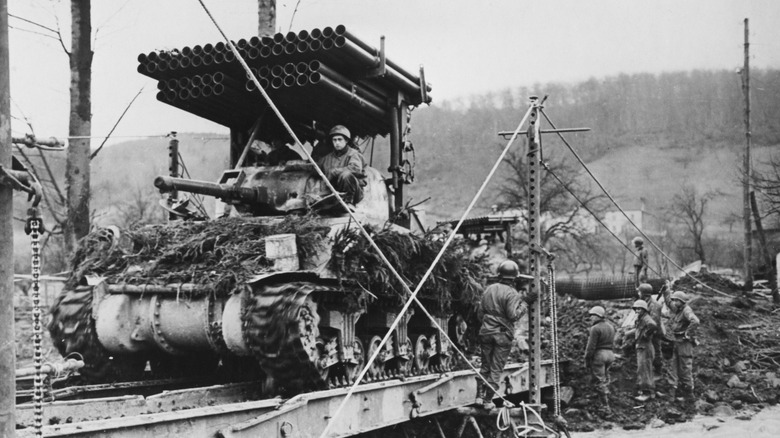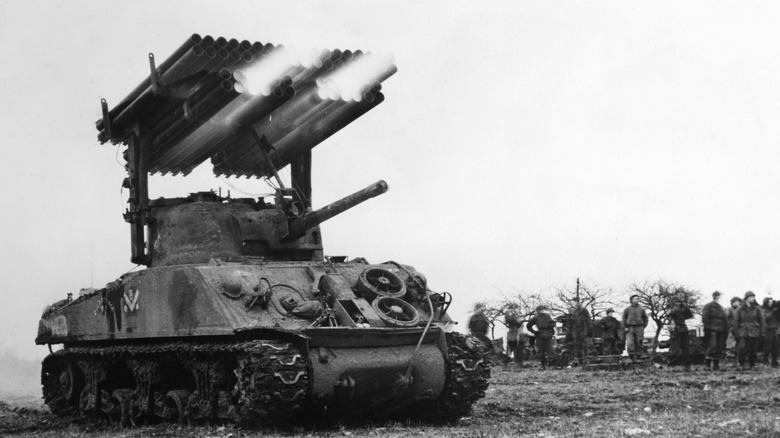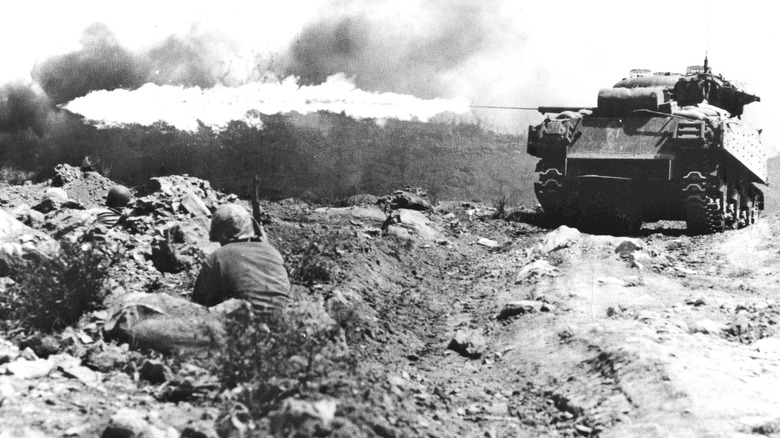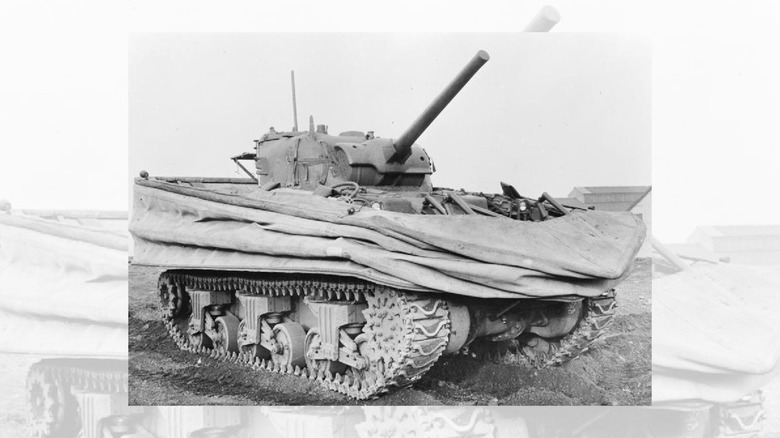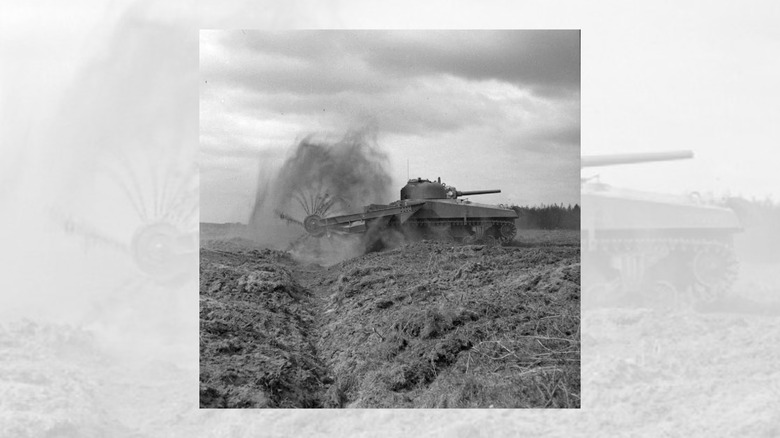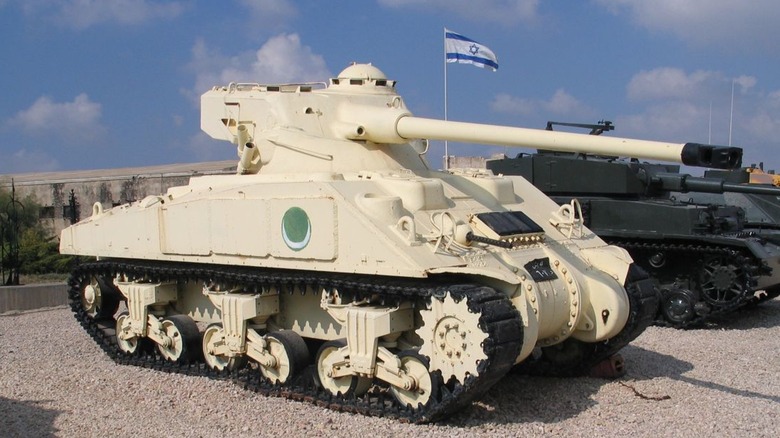5 Weird M4 Sherman Tanks That Made It To The Battlefield
The M4 Sherman is one of the most prolific tanks during the Second World War, with the Allied forces fielding over 50,000 units across all theaters. Aside from its sheer numbers, the M4 Sherman was also improved over time, getting more than 50 variants throughout its lifetime.
It was for this reason that the M4 Sherman tank was used in many battlefields long after Nazi Germany and Imperial Japan surrendered. It was even used as the basis for other vehicles, like the M7 Priest self-propelled gun and the M10 Wolverine, which is one of the best tank destroyers of WW2.
War is an unpredictable business, so even the many variants of the M4 Sherman couldn't possibly account for every scenario. Nevertheless, many countries often have the greatest and most creative minds serving them, leading to novel solutions that use existing technologies. If you combine that with the availability of the Sherman tank, you're bound to get some weird models that you wouldn't expect.
M4 Sherman Rocket Launcher T34 (Calliope)
Artillery is the heavy hammer armies use in the battlefield to defeat their enemies. Ever since the catapult was invented, large and heavy projectiles were used to destroy fortified positions and dislodge enemy infantry to make them easier to defeat. The United States saw this need and experimented by adding 60 tubes mounted above the M4 Sherman capable of launching the 4.5-inch M8 rocket.
This setup gave the Rocket Launcher T34 a maximum range of 4,200 yards, allowing it to hit enemy positions without being exposed to enemy fire. Because these were unguided rockets, the T34 wasn't exactly pinpoint accurate. However, the number of projectiles it launched simultaneously is more than enough to saturate a large area of the enemy position.
At the very least, this type of bombardment will disrupt the movement of infantry groups, destroy enemy equipment, and even collapse buildings and other permanent structures. The sound that each rocket makes as it homes in on the targeted area is enough to bring terror to any soldier pinned during the bombardment; that's why American troops called it the "Calliope" — after the Steam Organ that made a similar sound.
Sherman Crocodile Tanks
The British first made the Churchill Crocodile tank — a heavy tank which featured a flame projector in the front hull instead of the usual machine gun. Some American troops received support from these flame-spewing British tanks, which resulted in the development of the Sherman Crocodile.
Just like its bigger brother, the Sherman Crocodile towed an armored trailer behind it which contained the fuel and nitrogen tanks for the flamethrower. It then connected to the Sherman via three articulated joints that allowed it to move freely while the tank was traversing the battlefield. An armored pipe then runs along the right side of the tank, and it then leads to a flame projector mounted to the right of the bow-gunner.
The introduction of the Sherman Crocodile reduced the need for man-portable flamethrowers, which were far more dangerous to use. That's because infantry-borne flamethrowers are heavy weapons that makes it difficult for the solider to move. There could also be unreliable and makes the bearer a prime target for the enemy.
M4 Sherman DD Tanks
Operation Overlord was the greatest amphibious assault ever attempted before 1944. Over 129 thousand troops landed in the beaches of Normandy in June 1944, and the Allied high command knew that they needed tank support, especially as they're going up against Hitler's Atlantic Wall.
Because of this, the Allies developed the M4 Sherman DD tank — where DD stood for Duplex Drive. This development gave the M4 Sherman a canvas flotation screen that was raised up via an air compressor before it entered the water and two propellers to drive it forward. Once the tank hits the beaches, the crew could quickly release the screen and the tank could then move forward, engage targets, and support the assaulting infantry.
However, during the actual invasion, many Sherman DDs sank even before they reached the beach. The primary reason for this was that the tanks were launched in less-than-ideal conditions for which their crews hadn't trained for. Nevertheless, the Allied forces continued to use these tanks in further operations, including the crossing of the Rhine.
Sherman Crab Tank
Minefields limit the movement of ground forces, funneling them into pre-determined kill zones setup by the enemy. So, to catch them unaware or to force them to relocate and reorganize their forces, the Allies needed a way to get through these explosive obstacles. The US tried to make the Big Foot M4 Sherman to help clear minefields, but it was ultimately a failure.
Instead, the Allies found a simpler solution — the Sherman Crab. This tank is essentially an M4 Sherman with a rotating flail attach to its front. This attachment is a cylinder with several long chains attached to it and is then mounted to the front of the tank via two long arms. It's then rotated at high speed, with the chains hitting the ground ahead of the Sherman.
The ground impact these chains make is enough to detonate both anti-personnel and anti-tank mines in front of the tank. Since the mines detonate away from the Sherman's hull, it does not destroy or disable the tank, allowing the assault to continue. The infantry and other ground forces could then go through the cleared area, allowing them to safely bypass the minefield.
The French-Made M4A4 FL-10 of the Egyptian Army
Although the M4 Shermans were made in the 1940s, the tank's reliability, one of the Sherman's great strengths, meant that it saw action with the Egyptian army even during the '50s and '60s. However, the Egyptians knew that they needed to up-gun the Sherman to keep it combat-ready and useful in the battlefields of that time. But instead of modifying the M4 turret, which was an expensive proposition, French engineers worked with the Egyptian military to mount the FL-10 turret from the French AMX-13 light tank.
This replaced the traditional turret on the M4 Sherman tank with an oscillating turret and an automatic loader, giving the M4A4 FL-10 a much higher rate of fire compared to other manually loaded tanks. It also removed the loader, reducing its personnel requirement from five to four crew members.
The M4A4 FL-10 was theoretically an excellent tank, especially when paired with the reliability of the M4 Sherman with the fast-firing gun on the AMX-13. However, the Egyptian army did not train its tank crews well and failed to maintain the complicated mechanism of the French autoloaders. This meant that their tanks failed on the battlefield when they met the highly trained Israeli tankers during the 1956 Suez Crisis and the Six Day War of 1967.
